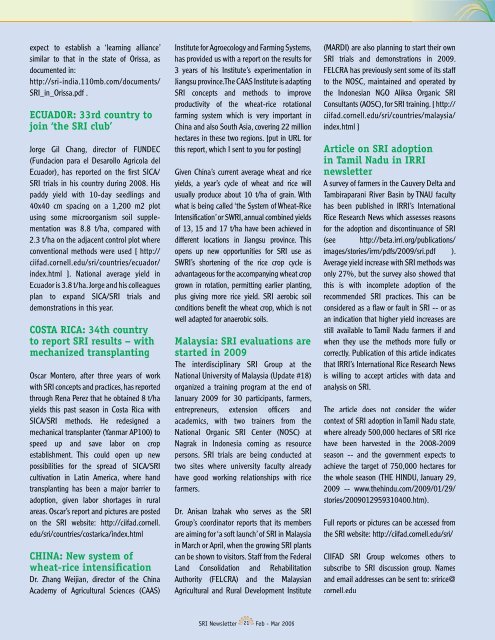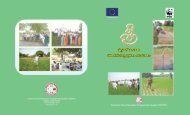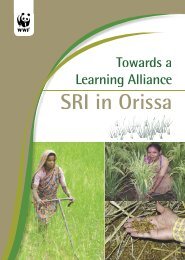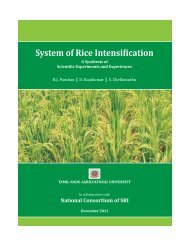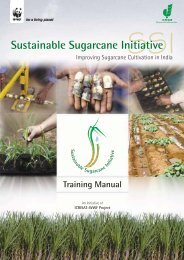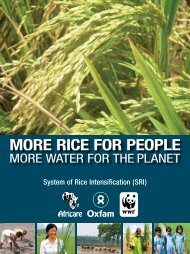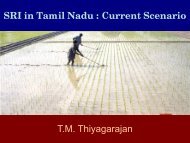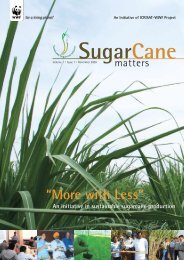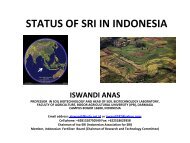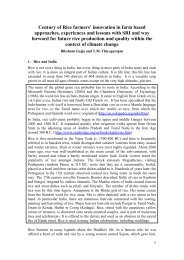Stretching Out SRI in Tamil Nadu - SRI - India
Stretching Out SRI in Tamil Nadu - SRI - India
Stretching Out SRI in Tamil Nadu - SRI - India
Create successful ePaper yourself
Turn your PDF publications into a flip-book with our unique Google optimized e-Paper software.
expect to establish a ‘learn<strong>in</strong>g alliance’<br />
similar to that <strong>in</strong> the state of Orissa, as<br />
documented <strong>in</strong>:<br />
http://sri-<strong>in</strong>dia.110mb.com/documents/<br />
<strong>SRI</strong>_<strong>in</strong>_Orissa.pdf .<br />
ECUADOR: 33rd country to<br />
jo<strong>in</strong> ‘the <strong>SRI</strong> club’<br />
Jorge Gil Chang, director of FUNDEC<br />
(Fundacion para el Desarollo Agricola del<br />
Ecuador), has reported on the first SICA/<br />
<strong>SRI</strong> trials <strong>in</strong> his country dur<strong>in</strong>g 2008. His<br />
paddy yield with 10-day seedl<strong>in</strong>gs and<br />
40x40 cm spac<strong>in</strong>g on a 1,200 m2 plot<br />
us<strong>in</strong>g some microorganism soil supplementation<br />
was 8.8 t/ha, compared with<br />
2.3 t/ha on the adjacent control plot where<br />
conventional methods were used [ http://<br />
ciifad.cornell.edu/sri/countries/ecuador/<br />
<strong>in</strong>dex.html ]. National average yield <strong>in</strong><br />
Ecuador is 3.8 t/ha. Jorge and his colleagues<br />
plan to expand SICA/<strong>SRI</strong> trials and<br />
demonstrations <strong>in</strong> this year.<br />
COSTA RICA: 34th country<br />
to report <strong>SRI</strong> results – with<br />
mechanized transplant<strong>in</strong>g<br />
Oscar Montero, after three years of work<br />
with <strong>SRI</strong> concepts and practices, has reported<br />
through Rena Perez that he obta<strong>in</strong>ed 8 t/ha<br />
yields this past season <strong>in</strong> Costa Rica with<br />
SICA/<strong>SRI</strong> methods. He redesigned a<br />
mechanical transplanter (Yanmar AP100) to<br />
speed up and save labor on crop<br />
establishment. This could open up new<br />
possibilities for the spread of SICA/<strong>SRI</strong><br />
cultivation <strong>in</strong> Lat<strong>in</strong> America, where hand<br />
transplant<strong>in</strong>g has been a major barrier to<br />
adoption, given labor shortages <strong>in</strong> rural<br />
areas. Oscar’s report and pictures are posted<br />
on the <strong>SRI</strong> website: http://ciifad.cornell.<br />
edu/sri/countries/costarica/<strong>in</strong>dex.html<br />
CHINA: New system of<br />
wheat-rice <strong>in</strong>tensification<br />
Dr. Zhang Weijian, director of the Ch<strong>in</strong>a<br />
Academy of Agricultural Sciences (CAAS)<br />
Institute for Agroecology and Farm<strong>in</strong>g Systems,<br />
has provided us with a report on the results for<br />
3 years of his Institute’s experimentation <strong>in</strong><br />
Jiangsu prov<strong>in</strong>ce. The CAAS Institute is adapt<strong>in</strong>g<br />
<strong>SRI</strong> concepts and methods to improve<br />
productivity of the wheat-rice rotational<br />
farm<strong>in</strong>g system which is very important <strong>in</strong><br />
Ch<strong>in</strong>a and also South Asia, cover<strong>in</strong>g 22 million<br />
hectares <strong>in</strong> these two regions. [put <strong>in</strong> URL for<br />
this report, which I sent to you for post<strong>in</strong>g]<br />
Given Ch<strong>in</strong>a’s current average wheat and rice<br />
yields, a year’s cycle of wheat and rice will<br />
usually produce about 10 t/ha of gra<strong>in</strong>. With<br />
what is be<strong>in</strong>g called ‘the System of Wheat-Rice<br />
Intensification’ or SWRI, annual comb<strong>in</strong>ed yields<br />
of 13, 15 and 17 t/ha have been achieved <strong>in</strong><br />
different locations <strong>in</strong> Jiangsu prov<strong>in</strong>ce. This<br />
opens up new opportunities for <strong>SRI</strong> use as<br />
SWRI’s shorten<strong>in</strong>g of the rice crop cycle is<br />
advantageous for the accompany<strong>in</strong>g wheat crop<br />
grown <strong>in</strong> rotation, permitt<strong>in</strong>g earlier plant<strong>in</strong>g,<br />
plus giv<strong>in</strong>g more rice yield. <strong>SRI</strong> aerobic soil<br />
conditions benefit the wheat crop, which is not<br />
well adapted for anaerobic soils.<br />
Malaysia: <strong>SRI</strong> evaluations are<br />
started <strong>in</strong> 2009<br />
The <strong>in</strong>terdiscipl<strong>in</strong>ary <strong>SRI</strong> Group at the<br />
National University of Malaysia (Update #18)<br />
organized a tra<strong>in</strong><strong>in</strong>g program at the end of<br />
January 2009 for 30 participants, farmers,<br />
entrepreneurs, extension officers and<br />
academics, with two tra<strong>in</strong>ers from the<br />
National Organic <strong>SRI</strong> Center (NOSC) at<br />
Nagrak <strong>in</strong> Indonesia com<strong>in</strong>g as resource<br />
persons. <strong>SRI</strong> trials are be<strong>in</strong>g conducted at<br />
two sites where university faculty already<br />
have good work<strong>in</strong>g relationships with rice<br />
farmers.<br />
Dr. Anisan Izahak who serves as the <strong>SRI</strong><br />
Group’s coord<strong>in</strong>ator reports that its members<br />
are aim<strong>in</strong>g for ‘a soft launch’ of <strong>SRI</strong> <strong>in</strong> Malaysia<br />
<strong>in</strong> March or April, when the grow<strong>in</strong>g <strong>SRI</strong> plants<br />
can be shown to visitors. Staff from the Federal<br />
Land Consolidation and Rehabilitation<br />
Authority (FELCRA) and the Malaysian<br />
Agricultural and Rural Development Institute<br />
<strong>SRI</strong> Newsletter 21 Feb - Mar 2009<br />
(MARDI) are also plann<strong>in</strong>g to start their own<br />
<strong>SRI</strong> trials and demonstrations <strong>in</strong> 2009.<br />
FELCRA has previously sent some of its staff<br />
to the NOSC, ma<strong>in</strong>ta<strong>in</strong>ed and operated by<br />
the Indonesian NGO Aliksa Organic <strong>SRI</strong><br />
Consultants (AOSC), for <strong>SRI</strong> tra<strong>in</strong><strong>in</strong>g. [ http://<br />
ciifad.cornell.edu/sri/countries/malaysia/<br />
<strong>in</strong>dex.html ]<br />
Article on <strong>SRI</strong> adoption<br />
<strong>in</strong> <strong>Tamil</strong> <strong>Nadu</strong> <strong>in</strong> IRRI<br />
newsletter<br />
A survey of farmers <strong>in</strong> the Cauvery Delta and<br />
Tambiraparani River Bas<strong>in</strong> by TNAU faculty<br />
has been published <strong>in</strong> IRRI’s International<br />
Rice Research News which assesses reasons<br />
for the adoption and discont<strong>in</strong>uance of <strong>SRI</strong><br />
(see http://beta.irri.org/publications/<br />
images/stories/irrn/pdfs/2009/sri.pdf ).<br />
Average yield <strong>in</strong>crease with <strong>SRI</strong> methods was<br />
only 27%, but the survey also showed that<br />
this is with <strong>in</strong>complete adoption of the<br />
recommended <strong>SRI</strong> practices. This can be<br />
considered as a flaw or fault <strong>in</strong> <strong>SRI</strong> -- or as<br />
an <strong>in</strong>dication that higher yield <strong>in</strong>creases are<br />
still available to <strong>Tamil</strong> <strong>Nadu</strong> farmers if and<br />
when they use the methods more fully or<br />
correctly. Publication of this article <strong>in</strong>dicates<br />
that IRRI’s International Rice Research News<br />
is will<strong>in</strong>g to accept articles with data and<br />
analysis on <strong>SRI</strong>.<br />
The article does not consider the wider<br />
context of <strong>SRI</strong> adoption <strong>in</strong> <strong>Tamil</strong> <strong>Nadu</strong> state,<br />
where already 500,000 hectares of <strong>SRI</strong> rice<br />
have been harvested <strong>in</strong> the 2008-2009<br />
season -- and the government expects to<br />
achieve the target of 750,000 hectares for<br />
the whole season (THE HINDU, January 29,<br />
2009 -- www.theh<strong>in</strong>du.com/2009/01/29/<br />
stories/2009012959310400.htm).<br />
Full reports or pictures can be accessed from<br />
the <strong>SRI</strong> website: http://ciifad.cornell.edu/sri/<br />
CIIFAD <strong>SRI</strong> Group welcomes others to<br />
subscribe to <strong>SRI</strong> discussion group. Names<br />
and email addresses can be sent to: sririce@<br />
cornell.edu


